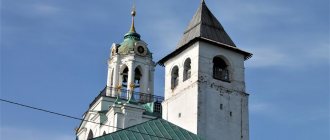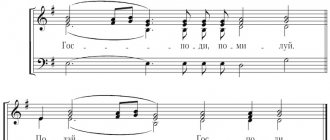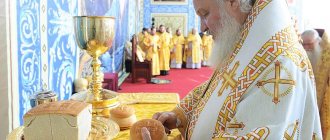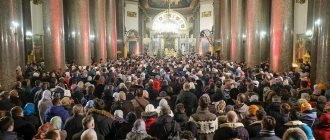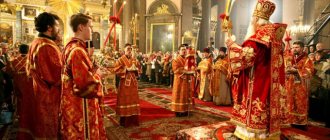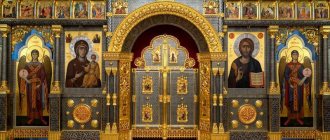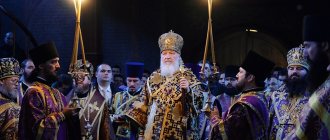The literal translation of the word “polyeleos” from Greek is “many mercy.” Due to the same sound, it is sometimes translated as “butter”. This is truly appropriate, since at the polyeleos service the bishop or cleric of the temple anoints the forehead of everyone who venerates the holiday icon.
At this time, the choir sings Psalms 134 and 135, repeatedly repeating the words “for His mercy endures forever.” Polyeleos is a solemn part of the divine service, therefore it occurs several times a year, always on Sundays or holidays. What is polyeleos in Orthodoxy? There are several answers to this question.
Church services
Orthodox churches are necessary for the performance of church services, the main of which is the Liturgy. Divine services are evening, morning and afternoon. They consist of parts, each of which has its own name, special role and symbolic meaning. Thus, on the eve of Great Holidays and Sunday services, after reading kathismas and special church chants, a special action is performed. All the lamps in the temple light up and the royal doors open. All the clergy solemnly go to the middle of the temple. This is how polyeleos begins. Polyeleos - what is it?
A priest anoints a believer with oil during polyeleos
What is worship?
The church has a main task - to raise the spiritual level of the individual and the entire society as a whole. This is why churches are necessary - they are the focus of spiritual life and allow the community of Christians to carry out public works and receive people.
Worship is a special time in the temple when people worship God
But for any society and its functioning, an organized order is necessary, therefore, services in the temple take place at a certain time and according to their own laws. A believer who regularly visits a temple must understand the order of services.
Worship is a special time in the temple when people worship God. It includes:
- singing psalms;
- reading akathists;
- priest's sermons.
Every action in the church has its own purpose, so the Divine Liturgy is a Sunday meeting at which the Sacrament of Communion is celebrated. It is considered the most important and central in the activities of the church, and the others are, as it were, preparation for it.
Polyeleos - what is it?
The Greek word "Polyeleos" consists of two parts: "πολυς" - "many" and "ελεος" - "mercy". Literally in Russian “Polieles” means “much merciful”, “many mercy”. This name refers to the solemn singing of Psalms 134 and 135. In the second of them, the words “For His mercy endures forever” are often repeated. Therefore, the name “Polyeleos” was assigned to the singing of these psalms.
Many people make the common mistake that the translation of the word “Polyeleos” is “much oil.” The misunderstanding arose due to the similarity in the sound of the Greek words for “mercy” (“ἔλεος”) and “oil” (“ἔλαιον”). An argument in favor of this misunderstanding is the use of oil (oil) in the polyeleous service. The tradition of anointing the foreheads of all those praying in the temple with blessed oil has been preserved to this day.
Prayer to Matrona of Moscow for healing
Unfortunately, not everyone knows a sufficient number of prayer requests to one or another saint. Since the example was given of the use of oil consecrated on the relics of Matrona of Moscow, the prayer will be directed specifically to her.
O blessed mother Matrono, hear and accept us now, sinners, praying to you, who throughout your entire life has learned to receive and listen to all those who suffer and mourn, with faith and hope who resort to your intercession and help, giving quick help and miraculous healing to everyone. May your mercy not fail now for us, unworthy, restless in this busy world and nowhere finding consolation and compassion in spiritual sorrows and help in bodily illnesses: heal our illnesses, deliver us from the temptations and torment of the devil, who passionately fights, help us convey our everyday Cross, to bear all the hardships of life and not lose the image of God in it, to preserve the Orthodox faith until the end of our days, to have strong trust and hope in God and unfeigned love for others; help us, after departing from this life, to achieve the Kingdom of Heaven with all those who please God, glorifying the mercy and goodness of the Heavenly Father, glorified in the Trinity, the Father and the Son and the Holy Spirit, forever and ever. Amen.
History of polyeleus
In Old Testament times, special night services were held to precede the beginning of a new day. In the early Christian period, a special service was compiled - Matins. Over time, her rank has undergone significant changes. Only individual psalms were left. And spiritual poets and hymn writers, such as Roman the Sweet Singer, composed special chants for Matins. The modern rite of Matins was consolidated by the Studite (9th century) and Jerusalem (11th century) Charters regulating the conduct of church services. The first mentions of the singing of the Polyelean psalms date back to this time.
Since the 15th century, the All-Night Vigil of the Polyeleos, along with the Litia (zealous prayer) and the Great Doxology, has been distinguished by prayerful intensity and the solemn participation of the clergy. Previously, during polyeleos, worshipers stood with lit candles. This testified to the spiritual burning of a person in a feeling of love for the Lord. This tradition has not survived to this day. In modern church practice, only the priest at the polyeleos holds a candle.
Polyelean Psalms
The content of Psalms 134 and 135 is consonant. In them, the chosen people of God, Israel, are called to praise the Creator (134, 6; 135, 5-9) and the Provider (134, 7; 135, 25). Thus, believers should express gratitude for all the mercies shown by the Creator. This is liberation from Egyptian slavery (134, 8-10; 135, 10-16) and the granting of the promised (promised) land (134, 10-12; 135, 17-20). For all this, the chosen people are obliged to remain faithful to God (134, 15-18). In some places the psalms literally repeat each other (134, 10-11 and 135, 17-20). The entire content of these psalms is filled with rapturous joy, which is poured out in grateful words.
Psalm 135 is more enthusiastic and solemn. For example, if in Psalm 134 verse 5 it says “Our Lord is gods above all,” then in Psalm 135 verses 2-3 it says “To the God of gods,” “Lord of lords.” Each verse of Psalm 135 is accompanied by the majestic refrain, “For His mercy endures forever.” Its repetition 26 times is most powerful in verses 17-20.
Here one sentence is divided into four parts by this refrain:
“He who has smitten the kings is great, for His mercy endures forever; and to him who slew mighty kings, for His mercy endureth forever; Zion, king of the Amorites, for His mercy endures forever; and Og, king of Bashansk, for His mercy endures forever.”
This
“a song of victory and proclaiming the wondrous deeds of God, especially the transition of our souls from the Egypt of sin and error to faith in Christ, our liberation from Pharaoh and the Egyptians, that is, the devil and demons, the liberation of the Church from Diocletian, Maximin and the apostate and other most wicked rulers, as if from Amalek, Zion, Og and the like - and after temptations and labors, entry into the promised land and heavenly inheritance through Jesus" (St. Simeon of Thessalonica, 14-15th century).
The Typikon and other liturgical books do not indicate the order of singing the polyeleos. According to established tradition, psalms are sung accompanied by choruses of “hallelujah” after each verse. Sometimes choruses are sung three times.
Oil healing
Holy oil is sold in every church shop. In small containers, most often with an icon glued to the bottle. This oil is poured after a prayer service to one or another saint. It must be used with prayer, anointing the forehead or sore spot on the body in a cross shape. Small children are often smeared this way.
For example, Orthodox mothers noticed that if, during epidemics of colds, they anoint their child with oil consecrated on the relics of the Matrona of Moscow, the risk of catching an infection is significantly reduced. We must not forget about prayer to the one whose oil is being anointed with.
Procedure for performing polyeleos
According to the Charter, after reading one of the kathismas and a small litany (prayerful petition), all the lights in the temple are turned on. This symbolizes the uncreated Light of God, which was revealed to people by the Son of God. The royal gates open. All clergy leave the altar and stand in the center of the temple in front of the icon of the holiday. Altar servers hand the priests lighted candles on special candlesticks. The choir solemnly reads the verses of the polyeleos psalms.
Next, the priest performing the service begins censing the entire temple (fumigation with incense). First, he approaches the icon of the holiday in the center of the temple while singing magnification. Then - to the altar (the high table standing in the middle of the altar). Then he leaves the altar, censes the iconostasis, the worshipers and the entire temple.
Polyeleos is accompanied by censing, which
“worship celebrates the most solemn and sacred moments. Symbolizing, as always, the power and piety of prayer, which really reaches the highest degree of tension when singing these psalms; symbolizing the grace of the Holy Spirit attracted by such prayer; Contributing to the uplifting of the spiritual mood with the pleasant smell of incense, incense in this case is also related to the memory associated with this part of Matins: it recalls that fragrant world that was dissolved “with merciful tears” at this hour of the night of the resurrection of the myrrh-bearer” (Mikhail Nikolaevich Skaballanovich, Explanatory Typikon).
According to established tradition, after the polyeleos, everyone present at the service kisses the icon of the holiday and the Gospel. As a reminder of the fraternal meal of the first Christians, accompanied by anointing with fragrant oil, the priest of the temple marks the sign of the cross on the forehead of those approaching the icon.
“Polyeleos represents a certain boundary in the evening worship. After it, it moves from a symbolic depiction of the intense expectation of the Messiah in the Old Testament to quiet joy about our Lord and Savior Jesus Christ who came into the world. In the sequence of the polyeleos, almost all the features of Orthodox worship are collected, symbolizing the joy of prayerful contact with God: the lighting of candles and all lamps, the festive incense, the loud and solemn singing of Sunday troparions or magnifications” (Priest Vasily Pistsov).
Part II. Services of the daily circle of worship
In the case of the Twelfth Feast of the Lord (on any day)
The features of such a service can be found in the Typikon in the sequences of September 14 and December 25.
Antiphons of the holiday
.
Upon entry:
troparion of the holiday; “Glory, even now”: kontakion of the holiday.
Prokeimenon, Apostle, Alleluia, Gospel
and
communion
- the holiday (ordinary Apostle and Gospel are transferred to the previous day, rarely - to the coming one).
Zadostoynik
holiday.
Vacation
short festive with an introductory phrase.
In the case of the twelfth feast of the Mother of God on a weekday
The features of such a service can be found in the Typikon in chapter 48 (September 8).
"Blessed":
The 3rd hymn of the 1st canon of the holiday is at 4 and the 6th hymn of the 2nd canon is for 4 (for the Feast of the Presentation of the Lord - the 3rd and 6th hymn of the canon of the holiday).
Upon entry:
troparion of the holiday; “Glory, even now”: kontakion of the holiday.
Prokeimenon, Apostle, Alleluia, Gospel
and
communion
- the holiday (ordinary Apostle and Gospel are transferred to the previous day, rarely - to the coming one).
Zadostoynik
holiday.
Vacation
short festive (for the Presentation of the Lord with an introductory phrase).
In the case of a non-twelfth feast of the Theotokos on a weekday
The service of the non-twelfth feast of the Theotokos is combined with the service of an ordinary saint. The features of such a service can be found in the Typikon following November 27.
"Blessed":
3rd hymn of the 1st canon of the Theotokos at 4 and 6th hymn of the 2nd canon of the Theotokos at 4.
Upon entry:
troparion of the Theotokos, troparion of the saint; “Glory”: kontakion of the saint, “And now”: kontakion of the Mother of God.
Prokeimenon, Apostle, Alleluia, Gospel
and
communion
- the Mother of God and the saint (ordinary Apostle and Gospel are transferred to the previous day, rarely to the coming one).
In the case of a vigil saint on a weekday day
The features of such a service can be found in the Typikon following September 26 and in the 52nd chapter.
"Blessed":
The 3rd canto of the saint's canon is at 4 and the 6th canto of the canon is at 4.
Upon entry:
– in the Church of the Lord or the Mother of God:
troparion of the temple, troparion of the saint; “Glory”: kontakion of the saint, “And now”: kontakion of the temple;
– in the temple of the saint:
troparion of the saint; “Glory”: kontakion of the saint, “And now”: “Representation of Christians...”.
Prokeimenon, Apostle, Alleluia, Gospel
and
communion
- a saint (ordinary Apostle and Gospel are transferred to the previous day, rarely - to the next).
In the case of the polyeleos saint on the weekday
Features of such a service can be found in the Typikon in the sequence of services to the polyeleos saints (for example, October 6 and 9), as well as in the 7th statutory chapter of the General Menaion and in the 52nd chapter of the Typikon.
"Blessed":
The 3rd canto of the saint's canon is at 4 and the 6th canto of the canon is at 4.
Upon entry:
– in the Church of the Lord or the Mother of God:
troparion of the temple, troparion of the saint; “Glory”: kontakion of the saint, “And now”: kontakion of the temple;
– in the temple of the saint:
troparion of the temple, troparion of the saint, kontakion of the temple; “Glory”: kontakion of the saint, “And now”: “Representation of Christians...”.
Prokeimenon, Alleluia
and
the communion
of the day and the saint (on Saturdays from the Sunday of All Saints to the Sunday of the Publican and the Pharisee, the Prokeimenon, Alleluia and the communion of the saint are sung first, then the communions of the day).
Apostle
and
the Gospel
- the ordinary and the saint (on Saturdays from the Sunday of All Saints to the Sunday of the Publican and the Pharisee, the saint is first read, then the ordinary).
In the case of a saint with great doxology on a weekday, except Saturday
The features of such a service can be found in the Typikon in the successions of the services on September 23 and October 23, as well as in the 8th statutory chapter of the General Menaion and in the 52nd chapter of the Typikon.
"Blessed":
The 3rd canto of the saint's canon is at 4 and the 6th canto of the canon is at 4.
Upon entry:
- in the Church of the Lord:
a)
on Monday, Tuesday and Thursday: troparion of the temple, troparion of the day (two on Thursday), troparion of the saint;
kontakion of the day (two on Thursday), “Glory”: kontakion of the saint, “And now”: kontakion of the temple; b)
on Wednesday and Friday: troparion of the day, troparion of the saint; “Glory”: kontakion of the saint, “And now”: kontakion of the day;
– in the Church of the Mother of God:
troparion of the temple, troparion of the day (on Wednesday and Friday the troparion of the day is sung first, and then the troparion of the temple), troparion of the saint; kontakion of the day, “Glory”: kontakion of the saint, “And now”: kontakion of the temple;
– in the temple of the saint:
troparion of the day, troparion of the temple, troparion of the saint, kontakion of the day, kontakion of the temple; “Glory”: kontakion of the saint, “And now”: “Representation of Christians...”.
Prokeimenon, Alleluia
and
is involved
in the day and the saint.
Apostle
and
the Gospel
- ordinary and holy.
On the occasion of a saint with great doxology on Saturday
In this case, the features are the same as in the case of the polyeleos saint, since the Octoechos are not sung at Matins (and therefore the day’s troparion and kontakion are not sung, see Chapter 52 of the Typikon).
"Blessed":
The 3rd canto of the saint's canon is at 4 and the 6th canto of the canon is at 4.
Upon entry:
– in the Church of the Lord or the Mother of God:
troparion of the temple, troparion of the saint; “Glory”: kontakion of the saint, “And now”: kontakion of the temple;
– in the temple of the saint:
troparion of the temple, troparion of the saint, kontakion of the temple; “Glory”: kontakion of the saint, “And now”: “Representation of Christians...”.
Prokeimenon, Alleluia
and
communion
- the saint and the day (from the Sunday of All Saints to the Sunday of the Publican and the Pharisee).
Apostle
and
the Gospel
- saints and ordinary people (from the Sunday of All Saints to the Sunday of the Publican and the Pharisee).
In the case of a sixfold saint on a weekday except Saturday
The features of such a service can be found in the Typikon in the successions of the services on September 5 and 24, as well as in the 9th statutory chapter of the General Menaion and in the 52nd chapter of the Typikon.
"Blessed":
Octoechos on 4 and the 3rd canto of the saint's canon on 4.
Upon entry:
- in the Church of the Lord:
a)
on Monday, Tuesday and Thursday: troparion of the temple, troparion of the day (two on Thursday), troparion of the saint;
Kontakion of the day (two on Thursday), kontakion of the saint. “Glory”: “Rest with the saints...”, “And now”: kontakion of the temple; b)
on Wednesday and Friday: troparion of the day, troparion of the saint; kontakion of the saint. “Glory”: “Rest with the saints...”, “And now”: kontakion of the day;
– in the Church of the Mother of God:
troparion of the temple, troparion of the day (on Wednesday and Friday the troparion of the day is sung first, and then the troparion of the temple), troparion of the saint; Kontakion of the day, kontakion of the saint. “Glory”: “Rest with the saints...”, “And now”: kontakion of the temple;
– in the temple of the saint
: troparion of the day, troparion of the temple, troparion of the Holy Menaion, kontakion of the day, kontakion of the temple; Kontakion of Saint Menaion. “Glory”: “Rest with the saints...”, “And now”: “Representation of Christians...”.
Prokeimenon, Alleluia
and
is involved
in the day and the saint.
Apostle
and
the Gospel
- ordinary and holy.
In the case of the sixfold saint on Saturday
The features in this case are indicated in the 12th and 52nd chapters of the Typikon.
"Blessed":
3rd canto of the saint's canon at 4 and Octoechos at 4.
Upon entry:
– in the Church of the Lord or the Mother of God:
troparia: the temple, the day (“Apostles, martyrs and prophets ...”) and the Holy Menaion; kontakion of the saint, “Glory”: “Rest with the saints...”, “And now”: kontakion of the day (“Like the firstfruits of nature...”);
– in the temple of the saint:
troparia of the day (“Apostles, martyrs and prophets…”) and Saint Menaion; Kontakion of Saint Menaion, “Glory”: “Rest with the saints...”, “And now”: kontakion of the day (“Like the firstfruits of nature...”).
Prokeimenon, Alleluia
and
communion
- the saint and the day (from the Sunday of All Saints to the Sunday of the Publican and the Pharisee).
Apostle
and
the Gospel
- saints and ordinary people (from the Sunday of All Saints to the Sunday of the Publican and the Pharisee).
In the case of a saint without a sign on a weekday except Saturday
The features of such a service can be found in the Typicon in the 48th chapter (for example, September 27) and in the 52nd chapter, as well as in the 10th statutory chapter of the General Menaion.
Everyday antiphons.
Upon entry:
- in the Church of the Lord:
a)
on Monday, Tuesday and Thursday: troparion of the temple, troparion of the day (two on Thursday), troparion of the saint;
Kontakion of the day (two on Thursday), kontakion of the saint. “Glory”: “Rest with the saints...”, “And now”: kontakion of the temple; b)
on Wednesday and Friday: troparion of the day, troparion of the saint; kontakion of the saint. “Glory”: “Rest with the saints...”, “And now”: kontakion of the day;
– in the Church of the Mother of God:
troparion of the temple, troparion of the day (on Wednesday and Friday the troparion of the day is sung first, and then the troparion of the temple), troparion of the saint; Kontakion of the day, kontakion of the saint. “Glory”: “Rest with the saints...”, “And now”: kontakion of the temple;
– in the temple of the saint:
troparion of the day, troparion of the temple, troparion of the Holy Menaion, kontakion of the day, kontakion of the temple; Kontakion of Saint Menaion. “Glory”: “Rest with the saints...”, “And now”: “Representation of Christians...”.
Prokeimenon, Alleluia
and
involved
- the day and the saint (if any).
Apostle
and
the Gospel
- ordinary and saint (if reading to a saint is indicated).
If the Charter does not indicate reading to the saint, then the prokeimenon, Alleluia and communion are sung only for the day, and the Apostle and the Gospel are read only to the ordinary (see Chapter 58 of the Typikon).
In the case of two saints without a sign on a weekday except Saturday
The features of such a service can be found in the Typikon in the 48th chapter (for example, September 2, 3) and in the 52nd chapter, as well as in the 10th statutory chapter of the General Menaion.
Everyday antiphons.
However, if one of the saints is indicated in the Typikon “Blessed” (very rarely, for example, September 3, October 22, January 22), then the pictorial antiphons are sung and the “Blessed” of the Octoechos on 4 and the 3rd hymn of the saint’s canon on 4 are read.
Upon entry:
– in the Church of the Lord:
a)
on Monday, Tuesday and Thursday: troparion of the temple, troparion of the day (two on Thursday), troparion of the 1st saint, troparion of the 2nd saint;
kontakion of the day (two on Thursday), kontakion of the 1st saint, kontakion of the 2nd saint. “Glory”: “Rest with the saints...”, “And now”: kontakion of the temple; b)
on Wednesday and Friday: troparion of the day, troparion of the 1st saint, troparion of the 2nd saint; kontakion of the 1st saint, kontakion of the 2nd saint. “Glory”: “Rest with the saints...”, “And now”: kontakion of the day;
– in the Church of the Mother of God:
troparion of the temple, troparion of the day (on Wednesday and Friday the troparion of the day is sung first, and then the temple), troparion of the 1st saint, troparion of the 2nd saint; Kontakion of the day, Kontakion of the 1st saint, Kontakion of the 2nd saint. “Glory”: “Rest with the saints...”, “And now”: kontakion of the temple;
– in the temple of the saint:
troparion of the day, troparion of the temple, troparion of the 1st Saint Menaion, troparion of the 2nd saint, kontakion of the day, kontakion of the temple; Kontakion of the 1st Saint Menaion, Kontakion of the 2nd Saint. “Glory”: “Rest with the saints...”, “And now”: “Representation of Christians...”.
Prokeimenon, Alleluia
and
involved
- the day and the saint (if any).
Apostle
and
the Gospel
- ordinary and saint (if reading to a saint is indicated).
If the Charter does not indicate reading to the saint, then the prokeimenon, Alleluia and communion are sung only for the day, and the Apostle and the Gospel are read only to the ordinary (see Chapter 58 of the Typikon).
In the case of a saint without a sign (one or two) on Saturday
The features in this case are indicated in the 12th and 52nd chapters of the Typikon.
"Blessed are you"
Octoechos on 6. However, in the case of two saints, if one of the saints is indicated in the Typikon “Blessed” (very rarely, for example, September 3, October 22, January 22), then “Blessed” is read at 8: 3rd canto of the saint at 4 and Octoechos at 4.
Upon entry:
– in the Church of the Lord or the Mother of God:
troparia: the temple, the day (“Apostles, martyrs and prophets ...”) and the saints of the Menaion (one or two); kontakion of saints (one or two), “Glory”: “Rest with the saints...”, “And now”: kontakion of the day (“Like the firstfruits of nature...”);
– in the temple of the saint:
troparia of the day (“Apostles, martyrs and prophets…”) and the Saints of the Menaion (one or two); kontakion of the saints of the Menaion (one or two), “Glory”: “Rest with the saints...”, “And now”: kontakion of the day (“Like the firstfruits of nature...”).
Prokeimenon, Alleluia
and
communion
- the saint (if any) and the day.
Apostle
and
the Gospel
- the saint (if any) and the ordinary.
If the Charter does not indicate reading to the saint, then the prokeimenon, Alleluia and communion are sung only for the day, and the Apostle and the Gospel are read only to the ordinary (see Chapter 58 of the Typikon).
In the case of a sixfold saint, a saint without a sign, or two saints on a weekday during the period of the forefeast of the twelfth feast
The features of such a service can be found in the Typikon in the 48th chapter (for example, September 7) and in the 52nd chapter, as well as in the 12th statutory chapter of the General Menaion.
"Blessed are you"
at 8: the 3rd hymn of the canon of the forefeast on 4 and the 6th hymn of the saint on 4.
If the saint does not have “Blessed”,
then the 3rd hymn of the canon of the forefeast is read on 4 and the 6th hymn of the forefeast on 4.
Upon entry:
– in the temple of the Lord
:
a)
on the forefeast of the Lord's feast: troparia of the forefeast and the Holy Menaion;
“Glory”: kontakion of Saint Menaion, “And now”: kontakion of the pre-celebration; b)
on the forefeast of the Theotokos feast: troparia: temple, forefeast, Holy Menaion; kontakion of the temple, “Glory”: kontakion of Saint Menaion, “And now”: kontakion of the pre-celebration;
- in the Church of the Theotokos:
a)
on the forefeast of the Lord's feast: troparia: the forefeast, the temple and the Holy Menaion;
kontakion of the temple, “Glory”: kontakion of Saint Menaion, “And now”: kontakion of the pre-celebration; b)
on the pre-celebration of the Mother of God feast: troparia: pre-celebration, Holy Menaion; “Glory”: kontakion of the saint, “And now”: kontakion of the pre-celebration;
– in the temple of the saint:
troparia: forefeasts, temple, holy Menaion; kontakion of the temple; “Glory”: kontakion of Saint Menaion, “And now”: kontakion of the pre-celebration.
In the case of two saints
troparia and kontakia are sung in succession to both saints, and on “Glory” in any church the kontakion of the 2nd saint is sung.
Prokeimenon, Alleluia
and
involved
- the day and the saint (if any).
Apostle
and
the Gospel
- ordinary and saint (if reading to a saint is indicated).
If the Charter does not indicate reading to the saint, then the prokeimenon, Alleluia and communion are sung only for the day, and the Apostle and the Gospel are read in private (see August 5).
In the case of a sixfold saint, a saint without a sign, or two saints on a weekday during the post-celebration of the twelfth feast
The features of such a service can be found in the Typicon in the 48th chapter (for example, September 9, 15) and in the 52nd chapter, as well as in the 12th statutory chapter of the General Menaion.
"Blessed are you"
on 8: the ordinary hymn of the canon of the holiday on 4 and the 6th hymn of the saint on 4.
If the saint does not have “Blessed
”, then either two ordinary hymns of the canon of the holiday are read on 8 (if there is a short period of post-feast, for example, September 10), or one ordinary holiday song on 6 (if there is a long period of post-feast, for example, September 19).
Entrance verse:
“Come, let us bow down and fall before Christ, save us, Son of God...” (further on, during the after-feast of the Lord’s feast, follows the refrain of the 2nd antiphon of the feast, and of the Theotokos, “Wonderful among the saints...”).
Upon entry:
- in the Church of the Lord:
a)
on the after-feast of the Lord's feast: troparions of the feast and the Holy Menaion;
“Glory”: kontakion of Saint Menaion, “And now”: kontakion of the holiday; b)
on the after-feast of the Theotokos feast: troparia: temple, holiday, saint; kontakion of the temple, “Glory”: kontakion of the saint, “And now”: kontakion of the holiday;
- in the Church of the Theotokos:
a)
on the after-feast of the Lord's feast: troparia: feast, temple and Saint Menaion;
kontakion of the temple, “Glory”: kontakion of St. Menaion, “And now”: kontakion of the holiday; b)
on the after-feast of the Theotokos feast: troparia: feast, Saint Menaion; “Glory”: kontakion of the saint, “And now”: kontakion of the holiday;
– in the temple of the saint:
troparia: holiday, temple, holy Menaion; kontakion of the temple; “Glory”: kontakion of Saint Menaion, “And now”: kontakion of the holiday.
In the case of two saints
troparia and kontakia are sung in succession to both saints, and on “Glory” in any church the kontakion of the 2nd saint is sung.
Prokeimenon, Alleluia
and
is involved
in the holiday and the saint (if any).
Apostle
and
the Gospel
- ordinary and saint (if reading to a saint is indicated).
Zadostoynik
holiday.
In the case of the polyeleos saint on the day of the week during the forefeast of the twelfth feast
The features of such a service can be found in the 11th statutory chapter of the General Menaion and in the 52nd chapter of the Typikon.
"Blessed are you"
on 8: 3rd hymn of the canon of the forefeast on 4 and 6th hymn of the saint on 4.
Upon entry:
- in the Temple of the Lord:
a)
on the forefeast of the Lord's feast: troparia of the forefeast and the Holy Menaion;
“Glory”: kontakion of Saint Menaion, “And now”: kontakion of the pre-celebration; b)
on the forefeast of the Theotokos feast: troparia: temple, forefeast, Holy Menaion; kontakion of the temple, “Glory”: kontakion of Saint Menaion, “And now”: kontakion of the pre-celebration;
- in the Church of the Theotokos:
a)
on the forefeast of the Lord's feast: troparia: the forefeast, the temple and the Holy Menaion;
kontakion of the temple, “Glory”: kontakion of Saint Menaion, “And now”: kontakion of the pre-celebration; b)
on the pre-celebration of the Mother of God feast: troparia: pre-celebration, Holy Menaion; “Glory”: kontakion of the saint, “And now”: kontakion of the pre-celebration;
– in the temple of the saint:
troparia: forefeasts, temple, holy Menaion; kontakion of the temple; “Glory”: kontakion of Saint Menaion, “And now”: kontakion of the pre-celebration.
Prokeimenon, Alleluia
and
is involved
in the day and the saint.
Apostle
and
the Gospel
- ordinary and holy.
In the case of the polyeleos saint on the weekday during the post-celebration of the twelfth feast
The features of such a service can be found in the Typikon in the 48th chapter (for example, August 9) and in the 52nd chapter, as well as in the 11th statutory chapter of the General Menaion.
"Blessed are you"
on 8: the ordinary hymn of the canon of the holiday on 4 and the 6th hymn of the saint on 4.
Entrance verse:
“Come, let us bow down and fall before Christ, save us, Son of God...” (further on, during the after-feast of the Lord’s feast, follows the refrain of the 2nd antiphon of the feast, and of the Theotokos, “Wonderful among the saints...”).
Upon entry:
- in the Church of the Lord:
a)
on the after-feast of the Lord's feast: troparions of the feast and the Holy Menaion;
“Glory”: kontakion of Saint Menaion, “And now”: kontakion of the holiday; b)
on the after-feast of the Theotokos feast: troparia: temple, holiday, saint; kontakion of the temple, “Glory”: kontakion of the saint, “And now”: kontakion of the holiday;
- in the Church of the Theotokos:
a)
on the after-feast of the Lord's feast: troparia: feast, temple and Saint Menaion;
kontakion of the temple, “Glory”: kontakion of St. Menaion, “And now”: kontakion of the holiday; b)
on the after-feast of the Theotokos feast: troparia: feast, Saint Menaion; “Glory”: kontakion of the saint, “And now”: kontakion of the holiday;
– in the temple of the saint:
troparia: holiday, temple, holy Menaion; kontakion of the temple; “Glory”: kontakion of Saint Menaion, “And now”: kontakion of the holiday.
Prokeimenon, Alleluia
and
is involved
in the holiday and the saint.
Apostle
and
the Gospel
- ordinary and holy.
Zadostoynik
holiday.
In the case of the saint's vigil per week
The features of such a service can be found in Chapter 3 of the Typikon.
"Blessed are you"
at 10: Octoechos at 6 and the 3rd canto of the saint’s canon at 4.
Entrance verse:
“Come, let us worship and fall before Christ, save us, Son of God, risen from the dead...” (this verse is always sung on Sunday).
Upon entry:
– in the temple of the Lord:
Sunday troparion, saint's troparion; “Glory”: saint’s kontakion, “And now”: Sunday kontakion;
– in the Church of the Mother of God:
the Sunday troparion, the temple troparion, the saint’s troparion; Sunday kontakion, “Glory”: saint’s kontakion, “And now”: temple kontakion;
– in the temple of the saint:
Sunday troparion, saint's troparion, Sunday kontakion; “Glory”: kontakion of the saint, “And now”: “Representation of Christians...”.
Prokeimenon, Alleluia
and
communion
- Sunday and Saint.
Apostle
and
the Gospel
- ordinary and holy.
In the case of a polyeleos or doxology saint or saint for 6 per week
The features of such a service can be found in chapters 4 and 5 of the Typikon.
"Blessed are you"
at 10: Octoechos at 6 and the 3rd canto of the saint’s canon at 4.
Upon entry:
– in the temple of the Lord:
Sunday troparion, saint's troparion; “Glory”: saint’s kontakion, “And now”: Sunday kontakion;
– in the Church of the Mother of God:
the Sunday troparion, the temple troparion, the saint’s troparion; Sunday kontakion, “Glory”: saint’s kontakion, “And now”: temple kontakion;
– in the temple of the saint:
troparia: Sunday, temple, saint, kontakion: Sunday, temple; “Glory”: kontakion of the saint, “And now”: “Representation of Christians...”.
Prokeimenon, Alleluia
and
communion
- Sunday and Saint.
Apostle
and
the Gospel
- ordinary and holy.
In the case of a saint without a sign in the week
The features of such a service can be found in Chapter 2 of the Typikon.
"Blessed are you"
Octoechos at 8.
Upon entry:
– in the temple of the Lord:
Sunday troparion, saint's troparion; “Glory”: saint’s kontakion, “And now”: Sunday kontakion;
– in the Church of the Mother of God:
the Sunday troparion, the temple troparion, the saint’s troparion; Sunday kontakion, “Glory”: saint’s kontakion, “And now”: temple kontakion;
– in the temple of the saint:
troparia: Sunday, temple, saint, kontakion: Sunday, temple; “Glory”: kontakion of the saint, “And now”: “Representation of Christians...”.
Prokeimenon, Alleluia
and
communion
- Sunday and Saint (if any).
Apostle
and
the Gospel
- ordinary and saint (if reading to a saint is indicated).
In case of two saints a week
The features of such a service can be found in the 4th chapter of the General Menaion.
"Blessed are you"
Octoechos on 8.
However, if the Rule assigns “Blessed” to a saint,
then “Blessed” by Octoechos on 6 and the 3rd hymn of the saint’s canon on 4 are read.
Upon entry:
– in the temple of the Lord:
troparia: Sunday, 1st saint, 2nd saint; kontakion of the 1st saint, “Glory”: kontakion of the 2nd saint, “And now”: Sunday kontakion;
– in the Church of the Mother of God:
troparia: Sunday, temple, 1st saint, 2nd saint; Sunday kontakion, kontakion of the 1st saint, “Glory”: kontakion of the 2nd saint, “And now”: kontakion of the temple;
– in the temple of the saint:
troparia: Sunday, temple, 1st saint, 2nd saint; kontakia: Sunday, temple, 1st saint; “Glory”: kontakion of the 2nd saint, “And now”: “Representation of Christians...”.
Prokeimenon, Alleluia
and
communion
- Sunday and Saint (if any).
Apostle
and
the Gospel
- ordinary and saint (if reading to a saint is indicated).
In the case of the polyeleos saint, during the period before or after the celebration of the twelfth feast of the week
The features of such a service can be found in the Typicon in the 48th chapter (for example, August 7) and in the 52nd chapter, as well as in the 5th statutory chapter of the General Menaion.
"Blessed are you"
at 12: Octoechos at 4, the ordinary hymn of the canon of the holiday (on the pre-feast day - the 3rd hymn of the canon) at 4 and the 6th hymn of the saint at 4.
Upon entry:
– in the temple of the Lord:
troparia: Sunday, holiday and saint; Sunday kontakion, “Glory”: saint’s kontakion, “And now”: holiday kontakion;
- in the Church of the Theotokos:
a)
on the pre- or post-feast of the Lord’s feast: troparia: Sunday, feast, temple and Saint Menaion;
kontakion of the Sunday and the temple, “Glory”: kontakion of St. Menaion, “And now”: kontakion of the holiday; b)
on the pre- or post-feast of the Mother of God: troparia: Sunday, holiday, Saint Menaion; Sunday kontakion, “Glory”: saint’s kontakion, “And now”: holiday kontakion;
– in the temple of the saint:
troparia: Sunday, holiday, temple, Holy Menaion; Sunday and temple kontakia; “Glory”: kontakion of Saint Menaion, “And now”: kontakion of the holiday.
Prokeimenon, Alleluia
and
communion
- Sunday and Saint.
Apostle
and
the Gospel
- ordinary and holy.
Zadostoynik
holiday (only after the holiday).
In the case of a saint without a sign or a sixfold one during the period before or after the celebration of the twelfth feast of the week
The features of such a service can be found in the Typikon in the 48th chapter (for example, August 7, September 8) and in the 52nd chapter, as well as in the 5th statutory chapter of the General Menaion.
"Blessed are you"
on 12: Octoeche on 4, the ordinary hymn of the canon of the holiday (on the pre-feast day - the 3rd hymn of the canon) on 4 and the 6th hymn of the saint on 4.
If the saint does not have “Blessed”,
then “Blessed” are read on 10: Octoeche on 6 and the canon of the holiday, an ordinary hymn (on the forefeast day - the 3rd hymn) on 4.
Upon entry:
– in the temple of the Lord:
troparia: Sunday, holiday and saint; Sunday kontakion, “Glory”: saint’s kontakion, “And now”: holiday kontakion;
- in the Church of the Theotokos:
a)
on the pre- or post-feast of the Lord’s feast: troparia: Sunday, feast, temple and Saint Menaion;
kontakion of the Sunday and the temple, “Glory”: kontakion of St. Menaion, “And now”: kontakion of the holiday; b)
on the pre- or post-feast of the Mother of God: troparia: Sunday, holiday, Saint Menaion; Sunday kontakion, “Glory”: saint’s kontakion, “And now”: holiday kontakion;
– in the temple of the saint:
Sunday troparia, holiday, temple, holy Menaion; Sunday and temple kontakia; “Glory”: kontakion of Saint Menaion, “And now”: kontakion of the holiday.
Prokeimenon, Alleluia
and
communion
- Sunday and Saint. However, if the saint does not have a prokeimenon (and everything else), then during the after-feast the prokeimenon, alleluia, and sacraments of Sunday and the holiday are sung.
Apostle
and
the Gospel
- ordinary and saint (if the saint does not have readings, then only the ordinary Apostle and Gospel are read).
Zadostoynik
holiday (only after the holiday).
When is the polyeleos service performed?
According to the Charter, polyeleos are celebrated during the festive morning before the great and some other holidays (in the church calendar they are marked with a red cross). Also, the polyeleos service is performed on the eve of the patronal feast. Patronal feast day is the day of a saint or event in whose memory the temple is consecrated. Currently, polyeleos are performed almost every Saturday, at the evening service, which is already considered Sunday. An exception is certain periods of the year when, according to the Charter, psalms 134 and 135 are replaced by the reading of the 17th kathisma (“Immaculate”). Thus, there is no polyeleos in the period from the week after Easter until the celebration of the Feast of the Exaltation (October 5, new style). Also, polyeleos psalms are not sung from January 2 (the pre-celebration of the Nativity of Christ) until January 27 (the celebration of the Feast of Epiphany). From Cheese Week (the week before the start of Lent) to Holy Week (the last week of Lent).
On Holy and Bright Week (the weeks before and after Easter), polyeleos are celebrated if specific holidays occur at this time. This is the Annunciation (April 7), the day of remembrance of the Great Martyr George the Victorious (May 6), or the patronal feast day of a particular church.
Read us conveniently on social networks:
Tags: polyeleos what is it, polyeleos what is it, polyeleos service, what is polyeleos
What is polyeleos in the Church
The answer to this question will help you better understand the intricacies of worship. Firstly, polyeleos is a remembrance of the myrrh-bearing women. After the crucifixion, the Savior was placed in a tomb, his body wrapped in shrouds. On Sunday morning, the women came to the tomb with vessels containing myrrh, a special fragrant oil. There they were met by an angel who announced the Resurrection of Christ. The most significant event in the history of mankind is marked by a solemn part of the service.
Secondly, answering the question of what polyeleos is, one cannot fail to mention God’s special grace poured out on Christians. During the earthly life of Jesus Christ, oil and ointment were of great value. As a sign of gratitude, honored guests were anointed with fragrant oil. The Gospel speaks of a woman who anointed the Savior’s feet with oil and wiped them with her hair, which speaks of her high virtue - humility. Today, it is also difficult to imagine your life without butter, not church butter, but regular butter - vegetable and butter.
In Orthodoxy there is a custom of thanking the Lord for his generosity. What is polyeleos? Roughly speaking, this is thanking God for the oil. Water-blessing prayers are a salute to the main liquid for everything that exists on earth. It is not for nothing that everything that has special value for a person is used in church sacraments. Bread and wine, products from which Holy Communion is prepared, prosphora and Easter bread - artos. All this is of great importance for Orthodox Christians and is especially revered. All these products are sacred.

